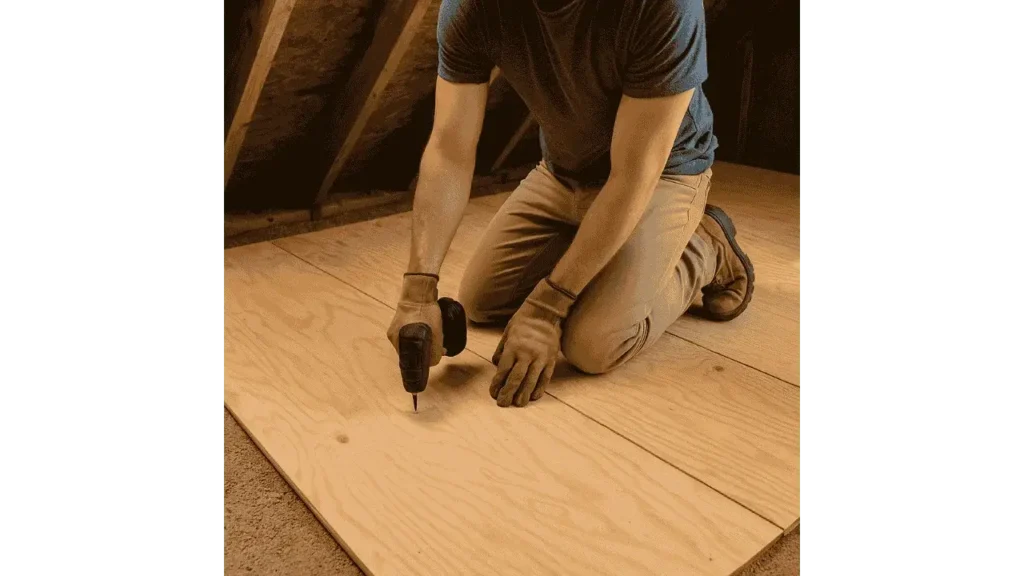Choosing the right size and type of plywood for your attic floor is essential for creating a safe, durable, and functional space. The attic often serves as extra storage or even a livable area, so the flooring must be strong enough to support heavy items and resist environmental factors like moisture. Understanding the best plywood size and type will help you make an informed decision and ensure your attic floor remains stable and long-lasting.

What is Plywood?
Plywood is a versatile engineered wood made from thin layers of wood veneer, glued together with alternating grain patterns. This cross-grain structure enhances its strength and durability, making it suitable for various structural applications, including flooring. Plywood is available in multiple thicknesses and grades, designed to meet different load and environmental needs.
Factors to Consider When Choosing Plywood for Attic Floors:
1. Thickness
The thickness of the plywood is critical for attic floors. For supporting heavy loads and frequent foot traffic, 3/4-inch (19mm) plywood is the industry standard due to its strength and durability. For lighter storage needs, 5/8-inch (16mm) plywood can be sufficient but may be more prone to sagging over time.
2. Load Capacity
Evaluate how much weight your attic floor will need to support. Heavy-duty storage areas or high-traffic spaces require thicker, higher-grade plywood to prevent bending or cracking. For basic storage, thinner plywood may work, but it’s always safer to choose thicker sheets for greater strength and stability.
3. Moisture Resistance
Attics can be prone to moisture buildup, especially in humid climates. Choosing moisture-resistant plywood, such as marine plywood or pressure-treated plywood, can protect against warping, mold, and structural damage. Installing a vapor barrier beneath the plywood can provide extra protection.
4. Cost
Your budget will influence the type of plywood you choose. While softwood plywood is more affordable and suitable for light storage, hardwood or marine plywood offers superior strength and moisture resistance. Balancing cost with durability ensures you get the best value for your investment.
Learn More: How to Remove Ink Stains From Wood Without Destroying It?
Why Use Plywood for Attic Floors?
Plywood is a popular choice for attic flooring because of its strength, stability, and cost-effectiveness. It provides a flat, even surface that can handle storage weight and occasional foot traffic. Its availability in various thicknesses makes it adaptable to different attic structures, ensuring the floor remains secure and functional.
Types of Plywood for Attic Floors:
1. Softwood Plywood
Softwood plywood, typically made from pine, fir, or spruce, is commonly used for attic floors due to its affordability and durability. It’s suitable for light to moderate storage and general use.
2. Hardwood Plywood
Hardwood plywood is made from hardwood species like oak, birch, or maple. It’s stronger and more durable than softwood plywood, making it ideal for attics that will hold heavier items or experience frequent foot traffic.
3. Structural Plywood
Structural plywood is designed for load-bearing applications. It offers excellent strength and stability, making it an ideal choice for attic floors intended to support significant weight.
4. Marine Plywood
Marine plywood is designed to withstand high moisture levels. While more expensive, it’s ideal for attics in humid or damp climates, providing superior resistance to warping and decay.
Installation Tips for Plywood in Attics:
Before installation, inspect the attic joists to ensure they can support the added weight. Use construction screws rather than nails for a more secure and squeak-free floor. Leave a 1/8-inch gap between plywood sheets to accommodate natural wood expansion. Additionally, consider installing insulation beneath the plywood to improve your home’s energy efficiency and prevent heat loss.
Conclusion:
Choosing the correct plywood for your attic floor is crucial for creating a safe and durable storage space. For heavy loads and frequent use, 3/4-inch structural or hardwood plywood is the most reliable option. In humid environments, moisture-resistant plywood like marine-grade is essential. Always consider the thickness, load capacity, and environmental conditions when selecting your plywood. With the right materials and proper installation, your attic floor will remain sturdy and functional for many years.
